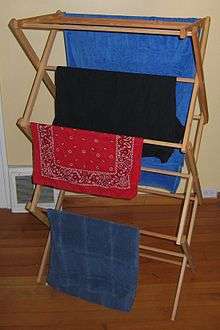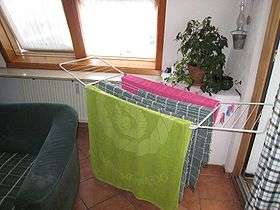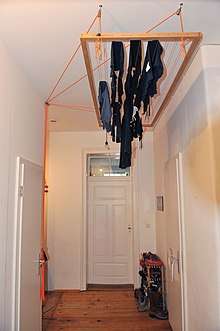Clothes horse



A clothes horse, sometimes called a clothes rack, drying horse, clothes maiden, garment donkey, drying rack, drying stand, Frostick, airer, or (Scots) winterdyke,[1] is a frame upon which clothes are hung after washing, indoors or outdoors, to dry by evaporation. The frame is usually made of wood, metal or plastic.
Types of drying racks
There are many types of drying racks, including large, stationary outdoor racks, smaller, folding portable racks, and wall-mounted drying racks. A drying rack is similar in usage and function to a clothes line, and used as an alternative to the powered clothes dryer.
A pulley clothes airer can be loaded and unloaded at a convenient height, and hoisted out of the way to ceiling height while the clothes dry. The racks are also used in kitchens, to hang utensils out of the way.
A pulley clothes airer is sometimes also described as "Victorian", "Edwardian", or "Lancashire" and then comprises two iron frames positioned as far apart as desired to provide a suitable length, with wooden laths, typically four or six, passed through holes in them. The frames are suspended from the ceiling by a system of rope and pulleys. The result is a hoistable rack with several parallel bars on which clothes can be draped out of the way, or hung, extending further down, with clothes hangers. [2][3]
A modern development uses a wooden frame with seven to eleven continuous clothes lines which increase the capacity of the clothes horse. The frame uses a clam cleat to tighten the clothes lines and hangs on four ropes. This increases the necessary installation effort, but also improves safety by increasing redundancy of the suspension. It uses a pulley system (block and tackle) which reduces the required force to lift the loaded frame. [4]
Figurative usage
Used figuratively, the single-word term clotheshorse describes men and women who are passionate about clothing and always appear in public dressed in the latest styles. From 1850 the term referred to a male fop or female quaintrelle, a person whose main function is, or appears to be, to wear or show off clothes.[5]
In this context, the term is similar to "fashion plate," which originally referred to a lithograph illustration of fashionable clothing in a book or magazine.
References
- ↑ "DYKE, DIKE, n. and v." Dictionary of the Scots Language. Scottish Language Dictionaries Ltd. Retrieved 8 January 2013.
- ↑ Typical parts available commercially to assemble a pulley airer
- ↑ Images found by Google image search for "pulley airer"
- ↑ A modern design of the clothes horse
- ↑ Oxford English Dictionary, 2nd ed., documents use of "clothes horse" in 1807, and "human clothes horse" in 1850